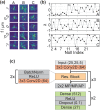Accurate phase retrieval of complex 3D point spread functions with deep residual neural networks
- PMID: 32127719
- PMCID: PMC7043838
- DOI: 10.1063/1.5125252
Accurate phase retrieval of complex 3D point spread functions with deep residual neural networks
Abstract
Phase retrieval, i.e., the reconstruction of phase information from intensity information, is a central problem in many optical systems. Imaging the emission from a point source such as a single molecule is one example. Here, we demonstrate that a deep residual neural net is able to quickly and accurately extract the hidden phase for general point spread functions (PSFs) formed by Zernike-type phase modulations. Five slices of the 3D PSF at different focal positions within a two micrometer range around the focus are sufficient to retrieve the first six orders of Zernike coefficients.
Copyright © 2019 Author(s).
Figures



References
-
- Shechtman Y., Eldar Y. C., Cohen O., Chapman H. N., Miao J. W., and Segev M., IEEE Signal Proc. Mag. 32, 87–109 (2015).10.1109/MSP.2014.2352673 - DOI
-
- Marchesini S., He H., Chapman H. N., Hau-Riege S. P., Noy A., Howells M. R., Weierstall U., and Spence J. C. H., Phys. Rev. B 68, 140101 (2003).10.1103/PhysRevB.68.140101 - DOI
-
- Jaganathan K., Eldar Y., and Hassibi B., “ Phase retrieval: An overview of recent developments,” in Optical Compressive Imaging, edited by Stern A. ( CRC Press, 2016).
-
- Gerchberg R. W. and Saxton W. O., Optik 35, 237–246 (1972).
-
- Guo C., Wei C., Tan J. B., Chen K., Liu S. T., Wu Q., and Liu Z. J., Opt. Laser Eng. 89, 2–12 (2017).10.1016/j.optlaseng.2016.03.021 - DOI
